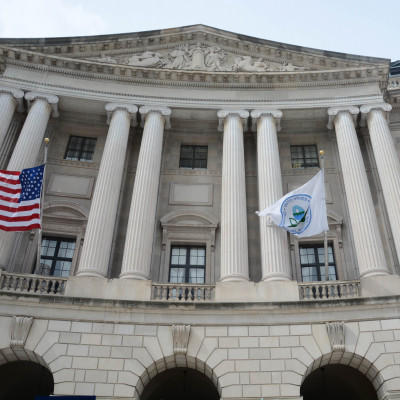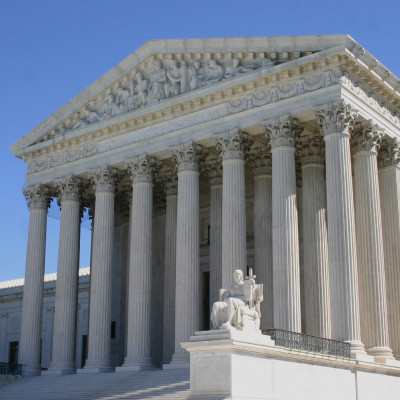August 1, 2024
July 2024 at Policy Integrity
- What Do Experts Think About the Future of Carbon Dioxide Removal?
- Court Rejects Effort to Pause Crucial Methane Emissions Rule
- Winter Storm Uri Sparks New Standard for Grid Reliability in Texas
- Chevron Deference May Be Over, But Agency Discretion Is Not
- 8/22 Virtual Training: Understanding Environmental Justice Laws and Policies
- More from This Month
-
_400_400_90_c1.jpg)
What Do Experts Think About the Future of Carbon Dioxide Removal?
Many governmental and corporate climate strategies increasingly rely on carbon dioxide removal (CDR). This approach, which involves pulling CO2 directly out of the air, can take many forms, including planting new forests and building “direct air capture” facilities. But concerns about costs, land-use and technological constraints, safety, environmental justice impacts, and other issues contribute to significant uncertainty about the future of CDR. Policy Integrity recently conducted the largest-ever expert elicitation study on this subject, surveying an interdisciplinary group of 699 leading researchers. The study revealed consensus on several key issues. First, experts identify numerous major barriers to widespread use of CDR, yet they predict huge growth, with a median of 2.3 gigatons of CO2 removed in 2050. (For context, EPA estimates the entire U.S. economy emitted about 5 gigatons of CO2 in 2022.) Experts also believe that cost and technology barriers can likely be overcome for most CDR approaches, including direct air capture, for which they predict a mean cost of $163/tonne in 2075, significantly lower than many projections. Despite this optimism, concerns about the impact of CDR on emissions mitigation efforts and gaps in its regulation still cloud the future, and many expert agree that CO2 removal is unlikely to grow fast enough to be consistent with net-zero goals. E&E News discussed our findings in an article published this week.
-

Court Rejects Effort to Pause Crucial Methane Emissions Rule
Earlier this year, a set of states and industry groups asked the U.S. Court of Appeals for the D.C. Circuit to pause or “stay” the implementation of EPA’s 2023 rule to limit methane emissions from the oil and gas sector. In addition to placing new limits on harmful methane emissions, this rule also updated EPA’s values for the social cost of greenhouse gases—a crucial metric used to monetize the benefits of emissions reductions in regulatory analysis. Our Economics Director, Peter Howard, authored an expert declaration defending the agency's development and use of new values for the social cost of methane (a component of the social cost of greenhouse gases) in the rule. This declaration was submitted to the court, along with others, by the Environmental Defense Fund. On July 9th, the Court rejected the request to pause the rule, allowing it to remain in effect while a further review continues.
-

Winter Storm Uri Sparks New Standard for Grid Reliability in Texas
Winter Storm Uri exposed massive issues with Texas’s electricity grid operator (ERCOT), leading to rolling blackouts and leaving millions without power. In response, the Texas Legislature asked the Public Utility Commission of Texas to enact a standard for ERCOT to use when determining reliability. The Commission proposed a multi-metric reliability standard—one that defines "reliability" not just in terms of the frequency of outages, but also in terms of their duration and magnitude. In comments to the Commission, Policy Integrity supported this overall approach because multi-metric reliability criteria are an emerging best practice. That said, we also suggested a few ways the Commission could strengthen its proposal. For example, it should include a stress test for the system based on specific catastrophic conditions (such as a Uri-like storm). Using historical data to simulate events is imperfect for predicting the likelihood of future disasters, especially as weather becomes increasingly extreme. Therefore, stress testing for resilience to new, extreme events can complement ERCOT's historical-data-based scenario modeling.
-

Chevron Deference May Be Over, But Agency Discretion Is Not
As the legal world continues to grapple with the ramifications of the Supreme Court’s decision in Loper Bright Enterprises v. Raimondo, it’s important to remember that agency discretion is not the same thing as court deference to agencies. In other words, even though the Court ended the practice of deferring to reasonable agency interpretations of ambiguous statutes they administer (known as Chevron deference), agencies are still able to exercise discretion when the law grants them authority to do so. Our Deputy Director, Don Goodson, makes this argument in a forthcoming paper in the Harvard Journal on Legislation. As an example, he references a case involving the Federal Energy Regulatory Commission which is often required by law to ensure that things like electricity rates are “just and reasonable.” Goodson argues that this “is not an ambiguous phrase; it is a broad, open ended phase that unambiguously conveys discretion.” As such, it should lead courts not to defer to FERC on a matter of interpretation but to affirmatively recognize that Congress has clearly granted the Commission a degree of discretion. The Supreme Court itself made this point in its Loper Bright decision, saying that a “statute’s meaning may well be that the agency is authorized to exercise a degree of discretion,” and “courts must respect the delegation” of this discretionary authority.
-

8/22 Virtual Training: Understanding Environmental Justice Laws and Policies
On August 22nd, Policy Integrity will host a training in which we will present a high-level overview of key laws and policies that require the consideration of environmental justice (EJ) in federal- and state-level decisionmaking. This training is part of a series that focuses on providing EJ communities with the tools to effectively engage with government at all levels. Starting with exploring the legal authority that state and federal governments have to consider EJ, we will review how the government is structured – executive, legislative, and judicial branches – and how each branch can advance EJ. The training will also cover related executive actions and policies implemented by Presidents and Governors, as well as the agencies that are part of the executive branch and their roles on EJ issues. Attendees do not need a background in EJ law or policy. This event and series are presented by Policy Integrity in its role as a coalition partner in EPA's Region 2 Thriving Communities Technical Assistance Center.
-
More from This Month
- We submitted comments to:
- The EPA Science Advisory Board on its Draft Peer Review Report on EPA’s Draft Revised Environmental Justice Technical Guidance
- The Department of Energy on draft goals for its Environmental Justice Strategic Plan
- The Illinois Commerce Commission on a Draft Phase 1 Report from its Future of Gas Workshops
- The California Public Utilities Commission on its Safety, Reliability, and Resilience Rules for Electrical Distribution Systems
- We submitted comments to:
